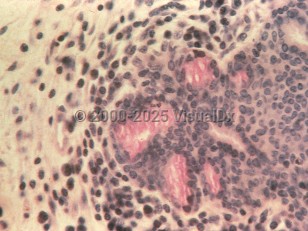Vulvodynia - Anogenital in
Alerts and Notices
Important News & Links
Synopsis

Vulvodynia is the term for vulvar pain lasting for at least 3 months in the absence of specific pain-producing disorders. No infections, dermatoses, or tumors are found. This pain is lesion-free. The pain can be generalized over the whole vulva or localized over part of the vulva. It is thought to be due to hypertonic pelvic floor musculature in the setting of psychosexual dysfunction and/or central neuropathic pain. Vulvodynia is the most common cause of dyspareunia.
Localized vulvar pain when found around the vulvar vestibule was formerly referred to as vulvar vestibulitis. Classically, in this localized condition, there is pain on touching the vestibule or on penetration, with erythema around the glandular orifices of the vulvar vestibule. It is the most common cause of vulvodynia (lesion-free vulvar pain). The most common location is the clitoris (clitorodynia). Onset of symptoms often is between the ages of 18 and 25, but it can take years for patients to present for care. Many patients have seen multiple providers before getting properly diagnosed. Symptoms can be triggered by tight clothing, tampon insertion, sexual intercourse, prolonged sitting, or gynecology examinations. Origins of the condition are unclear but are possibly related to an abnormal response to yeast infections, trauma, or irritation such as from laser or trichloroacetic acid. Symptoms could also be triggered by nerve injuries, localized inflammatory issues, or pelvic floor muscle problems. Vulvodynia can be associated with other pain conditions such as fibromyalgia, temporomandibular joint disease, migraines, interstitial cystitis, pelvic pain, and irritable bowel syndrome. Patients will complain of burning and/or itching as well as pain with intercourse. Pain can have sudden onset and then gradual recovery.
In the generalized form, there is diffuse, constant vulvar pain. It is described as rawness, burning, or a lancinating pain. It may be associated with an injured nerve from back problems, trauma to the pelvic area, or herpes simplex virus (HSV) or herpes zoster (VZV) infection causing neuropathy. Less commonly, it can be associated with centralized pain / complex pain conditions such as fibromyalgia, temporomandibular joint disease, interstitial cystitis, or irritable bowel syndrome. This can be found in women of any age but is more common in patients older than 40 years. Generalized vulvodynia should be differentiated from localized vulvodynia.
Localized vulvar pain when found around the vulvar vestibule was formerly referred to as vulvar vestibulitis. Classically, in this localized condition, there is pain on touching the vestibule or on penetration, with erythema around the glandular orifices of the vulvar vestibule. It is the most common cause of vulvodynia (lesion-free vulvar pain). The most common location is the clitoris (clitorodynia). Onset of symptoms often is between the ages of 18 and 25, but it can take years for patients to present for care. Many patients have seen multiple providers before getting properly diagnosed. Symptoms can be triggered by tight clothing, tampon insertion, sexual intercourse, prolonged sitting, or gynecology examinations. Origins of the condition are unclear but are possibly related to an abnormal response to yeast infections, trauma, or irritation such as from laser or trichloroacetic acid. Symptoms could also be triggered by nerve injuries, localized inflammatory issues, or pelvic floor muscle problems. Vulvodynia can be associated with other pain conditions such as fibromyalgia, temporomandibular joint disease, migraines, interstitial cystitis, pelvic pain, and irritable bowel syndrome. Patients will complain of burning and/or itching as well as pain with intercourse. Pain can have sudden onset and then gradual recovery.
In the generalized form, there is diffuse, constant vulvar pain. It is described as rawness, burning, or a lancinating pain. It may be associated with an injured nerve from back problems, trauma to the pelvic area, or herpes simplex virus (HSV) or herpes zoster (VZV) infection causing neuropathy. Less commonly, it can be associated with centralized pain / complex pain conditions such as fibromyalgia, temporomandibular joint disease, interstitial cystitis, or irritable bowel syndrome. This can be found in women of any age but is more common in patients older than 40 years. Generalized vulvodynia should be differentiated from localized vulvodynia.
Codes
ICD10CM:
N94.819 – Vulvodynia, unspecified
SNOMEDCT:
238968009 – Vulvodynia
N94.819 – Vulvodynia, unspecified
SNOMEDCT:
238968009 – Vulvodynia
Look For
Subscription Required
Diagnostic Pearls
Subscription Required
Differential Diagnosis & Pitfalls

To perform a comparison, select diagnoses from the classic differential
Subscription Required
Best Tests
Subscription Required
Management Pearls
Subscription Required
Therapy
Subscription Required
References
Subscription Required
Last Reviewed:08/11/2020
Last Updated:09/23/2020
Last Updated:09/23/2020

